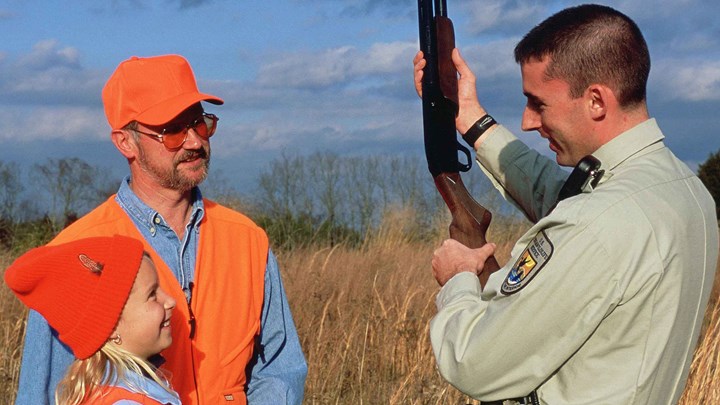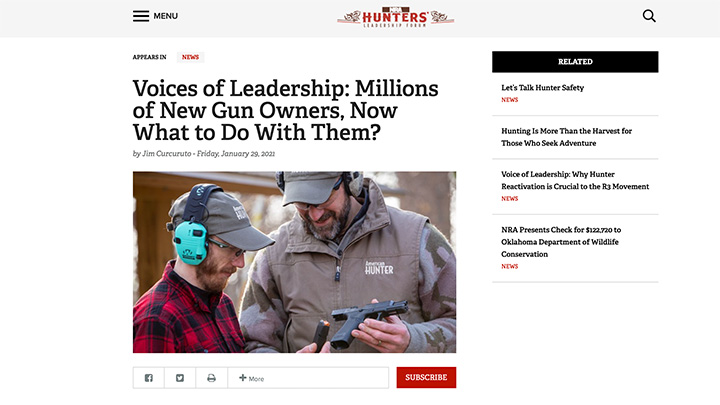
by Cody McLaughlin - Monday, July 11, 2022

From time to time we hear about an accident someone had while hunting, such as falling while climbing into a treestand or not properly identifying a target. Though rare, these reports always break my heart because, as a fellow hunter, it is easy to remember back to when I was a young and inexperienced hunter who could have fallen into the same trap. However, accidents are preventable. Hunters and prospective hunters shouldn’t let concerns over safety discourage them from going afield or let the non-hunting public get away with implying that hunting is an unsafe activity. In fact, the opposite is true: Hunting is one of the safest sports in America.
In 2019, I came across the article, “Hunting is Safer Than Golfing, Hiking,” which documented a national study showing that the injury rate for hunters is below that of almost every other activity. It’s easy to see why. We hunters are unique in that we receive extensive firearm and hunter safety training before ever going afield. Don’t take my word for it, though. Statistics back us up here. The article cited a study by American Sports Data, Inc., which shares some startling numbers about one’s chances of injury based on the given sport. Basketball leads the pack, with players having a 13.8 percent chance of injury, while joggers sit at an 8.2 percent chance. And then there is hunting, which trails far behind with a 1 percent chance of injury. Even golf sits at a higher chance of injury at 1.4 percent.
As experienced hunters, we should always remember to take a moment to make sure the new and/or younger hunters in our midst learn to recognize how to avoid making critical mistakes. This is maybe more important than ever considering the rise in firearm ownership and hunting license sales since the pandemic, with 8 million new guy buyers in 2020 alone. Fortunately, there are resources available, starting with the NRA.

Did you know the NRA is the leader in firearm and hunter safety training—and has been so for decades? In fact, the NRA built the first ever hunter safety curriculum in the United States in 1949 for the state of New York. It was that course and the materials provided by the NRA that trained all new hunters nationwide until the mid-1970s. During that time, the hunter safety card you were issued even said "NRA Hunter Safety" on it.
Fast forward a few decades and, in 2017, the NRA launched its free Online NRA Hunter Education Course to offer new hunters a convenient, interactive and free option for completing the mandated state-based requirements to become a hunter. Currently available in 12 states, the course aids the national R3 movement to “Retain, recruit and reactivate” hunters. The program is available online at NRAHE.org. To date, more than 100,000 students have completed the course, with another 60,000 in the process. (To learn how to get it be adopted for use in your state, email hservices@nrahq.org.)
For more good news, in June 2019, the U.S. Fish and Wildlife Service (USFWS) approved the free NRA Online Hunter Ed Course as a qualifying match for states to access Pittman Robertson funding. This marked a huge win for both the state agencies and the students. The USFWS’ approval has far-reaching and positive implications when it comes to the future of how the USFWS views “in kind” donations.
Because an accident can happen to an experienced hunter as well as to a novice, the NRA also offers an online refresher course for seasoned hunters known as the Experienced Hunter Education Course. As time goes on, some hunters forget parts of their hunter education training or the training they initially received was subpar. Now they also have a great way to brush up on their knowledge and skills.
For the younger crowd, another great program is the NRA Youth Hunter Education Challenge (YHEC), which provides a fun environment for kids ages 18 and under to improve their hunting, marksmanship and safety skills through simulated hunting situations, live-fire exercises and educational and hunter-responsibility events. YHEC builds on skills learned in basic hunter education courses and encourages safer, lifelong hunting habits. Launched in 1985, the program has reached over 1.4 million young hunters. It is open to any hunter who has completed hunter safety training at the state level and is comprised of eight activities: archery, muzzleloader, rifle and shotgun events as well as a hunter responsibility exam, hunter safety trail challenge, orienteering (map-and-compass training) and wildlife identification.
While treestand accidents are the No. 1 cause of hunting accidents, hunters also must remember to always handle firearms with care and make sure any hunters they mentor know to follow basic gun safety rules, starting with the NRA’s fundamental rules of gun safety:
• ALWAYS keep the gun pointed in a safe direction.
• ALWAYS keep your finger off the trigger until ready to shoot.
• ALWAYS keep the gun unloaded until ready to use.
Notice that the word “always” is in all caps. That’s because safety should be the top priority while hunting so we avoid injuries—or worse. Thankfully there are many ways to stay safe without having to give up our sense of adventure.
So go out and enjoy nature—safely. And encourage others to take advantage of some great education and training resources for hunters, such as those offered by the NRA, so we can continue to make sure hunting remains one of the safest activities out there.
About the Author
Cody McLaughlin is a noted conservationist and conservative thought leader on public policy issues including hunting, fishing, gun rights, free-market tax and wage policy and the environment. He works as a GOP consultant for conservative political causes, managing clients’ digital communications and online presence and as a trustee of the New Jersey Outdoor Alliance, helping to represent the state’s 1.2 million sportsmen in the political arena.
E-mail your comments/questions about this site to:
EmediaHunter@nrahq.org
